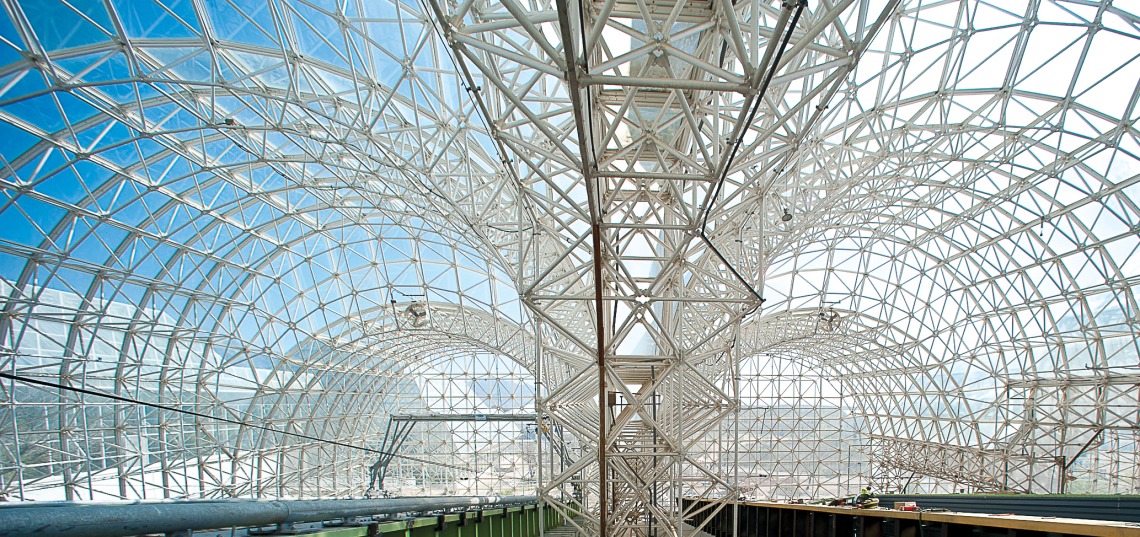The Resilient Planet
$30 million gift invests in the future of Earth

‘Biosphere 2 is a living laboratory where scientists do incredibly compelling work to better understand our environment.’
The world’s population — already close to 8 billion — is expected to surpass 11 billion by the end of the century. How can we scale food, water and energy systems to sustain the generations to come during a time of rapid climate change?
Researchers are working on these interconnected challenges at the largest closed ecological system in the world, the University of Arizona’s Biosphere 2.
Ed Bass, one of the visionaries behind the original project, has committed $30 million to sustain use of the nearly 40-acre research campus into the next decade and beyond. His endowment includes support for two faculty chairs that are part of the Eminent Scholars program, through which funding is amplified by the university to facilitate faster growth of the endowment’s principal.
“The Biosphere works at the nexus of food, energy and water,” explains Joaquin Ruiz, director of Biosphere 2, vice president for innovation and dean of the College of Science. These systems are interconnected: Water is used in energy production — including in growing biofuels — and agriculture alike. Changes in one system may have unexpected ramifications for another, yet traditionally scientists haven’t integrated their studies across research silos.
“Biosphere 2 is a laboratory unlike any other in the world, because it can advance our understanding of hydrology, geology, ecology, chemistry and atmospheric sciences in ways that could never be replicated in the real world,” says Kimberly Andrews Espy, senior vice president for research at the UA.
Under the UA’s stewardship, Biosphere 2 has become a global, multidisciplinary hub for environmental change research while also serving the nearly 100,000 visitors who come to explore the facility every year.
“Biosphere 2 is a living laboratory where scientists do incredibly compelling work to better understand our environment,” says UA President Robert C. Robbins. “This work is directly applicable to successful crop growth and even growing food on other planets. It looks to our collective future while building on the core competencies we have here at the UA. I am very grateful to Mr. Bass for his generosity and for what this gift will help the University of Arizona accomplish.”
“Biosphere 2 is the missing link between the laboratory and the real world,” says Ruiz. “It’s a single place where we can integrate forecasting, scenario evaluation and science-based policy making. I know the team working at Biosphere 2 shares my gratitude for Ed Bass’ continued investment in this project. The world needs more people with vision like his.”
A History of the ‘Earth in a Bottle’
Biosphere 2 first took the world’s attention in 1991, when eight crew members entered the facility and sealed themselves in for two years of study, with the aim of sustaining themselves on food they grew in the structure.
“In the 1970s, my colleagues and I studied biomes and their interconnectedness,” says Ed Bass. “The big idea that came after 10 years work was to build an experimental apparatus to emulate the biosphere of earth — a second biosphere.”
Bass funded the project, which was inspired by the work of innovative thinkers ranging from Vladimir Vernadsky, who coined the word “biosphere,” to Buckminster Fuller. The initiative was led by inventor John P. Allen.
“If you’re going to understand the planet where we live, you have to understand the biosphere of the planet and the influence of life on shaping the planet itself,” Bass says. “And, if you’re going to understand the whole, it’s useful to start by understanding the parts.” Accordingly, Biosphere 2 features five biome areas: rainforest, ocean, savannah, desert and marsh.
Biosphere 2 hosted two residential missions — each of which came with well-publicized challenges — before Columbia University took over management in 1995.
“Columbia conducted great research at the facility,” says Joaquin Ruiz. The UA leased Biosphere 2 in 2007, then the remarkable structure was given to the UA in 2011. “Over the past 10 years, we’ve expanded efforts that Columbia began. The university has invested in its success and sees it as an important differentiator.”
